Blockchain Software Development: Thorough Overview
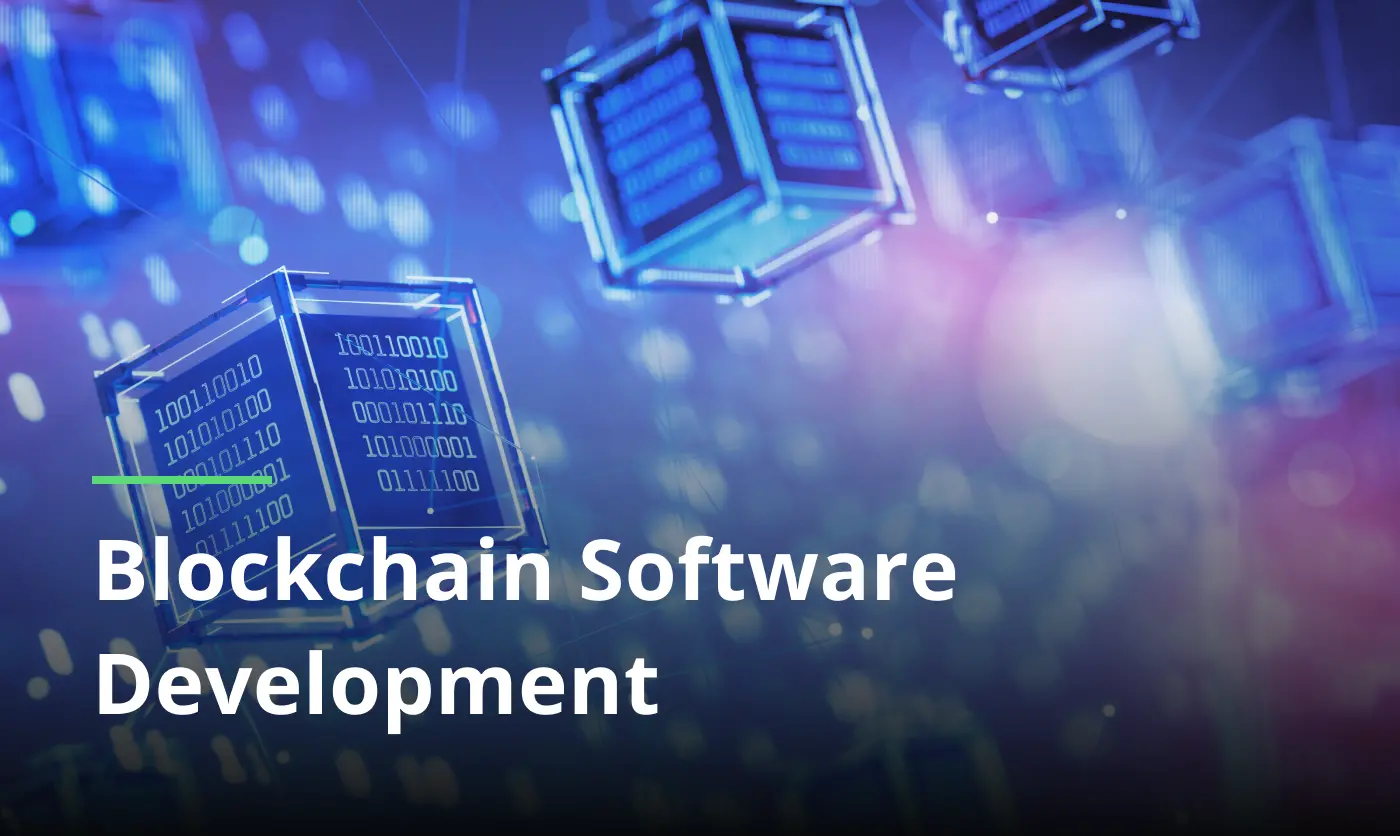
Blockchain software development has expanded much beyond its roots in cryptocurrency. Outdated methods are left behind as digital infrastructure depends on them to propel ecosystems where security, transparency and autonomy are imperative. This guide, made by us maps out the true meaning of financial solutions, the reasons for its popularity among international players and what to anticipate while creating one from the ground up.
Developing blockchain software demands a thorough grasp of the processes, delving into core principles to design secure and effective frameworks. Behind every well-oiled platform built with blockchain technology is a string of precise steps, critical decisions and a few tightrope walks between innovation and regulation.
Without a well-thought-out plan, blockchain in software development may quickly become a complicated and uncertain workflow. Our article also tackles pricing strategies, real-world development rates and how to spot a reliable partner in a crowded field. Limeup’s approach is grounded in experience and precision, delivering blockchain solutions that lead the way in efficiency and innovation. Let’s dig in.
What is a blockchain solution?
A digital chain of blocks requires one thousand security locks that each participant controls. Such a system operates to store, verify and transmit data across the network independently from centralized authority oversight for truthfulness. The blockchain technology maintains direct trust insertion into its base so businesses are able to secure transactions by moving assets through decentralized ledgers.
At its core, blockchain software development solves one timeless problem: how to create absolute openness without sacrificing control. Information shows up on the chain forever as an immutable thread throughout its complete historical record which is available for inspection by those who have access permissions. Disclosure exists without any manipulation while complete past alterations become impossible.
A growing number of innovations in finance and healthcare and real estate as well as entertainment arise from this approach. Applications follow distinct architectural models. Some are open to public participation, while others operate within closed environments to preserve confidentiality and control.
The demand ranges between solutions that enable automatic contract execution with smart contracts and features that monitor supply chains and secure user identities. Trust and credible data management go hand in hand via decentralized networks, strengthening responsibility and consistency. Anything should never be built on unsteady ground.
These days, distributed ledgers keep the wheels from falling off and transform once dubious corporate transactions into common, openly validated assurances. A skilled blockchain development team is able to chart this terrain with precision, building reliable frameworks that stand up under scrutiny. Such an upcoming horizon stands as a sound bet worth pursuing.
Types of blockchain solutions
Not all blockchain tools are made equal. Different needs necessitate different approaches blockchain possesses more than a single trick up its sleeve to respond to them.
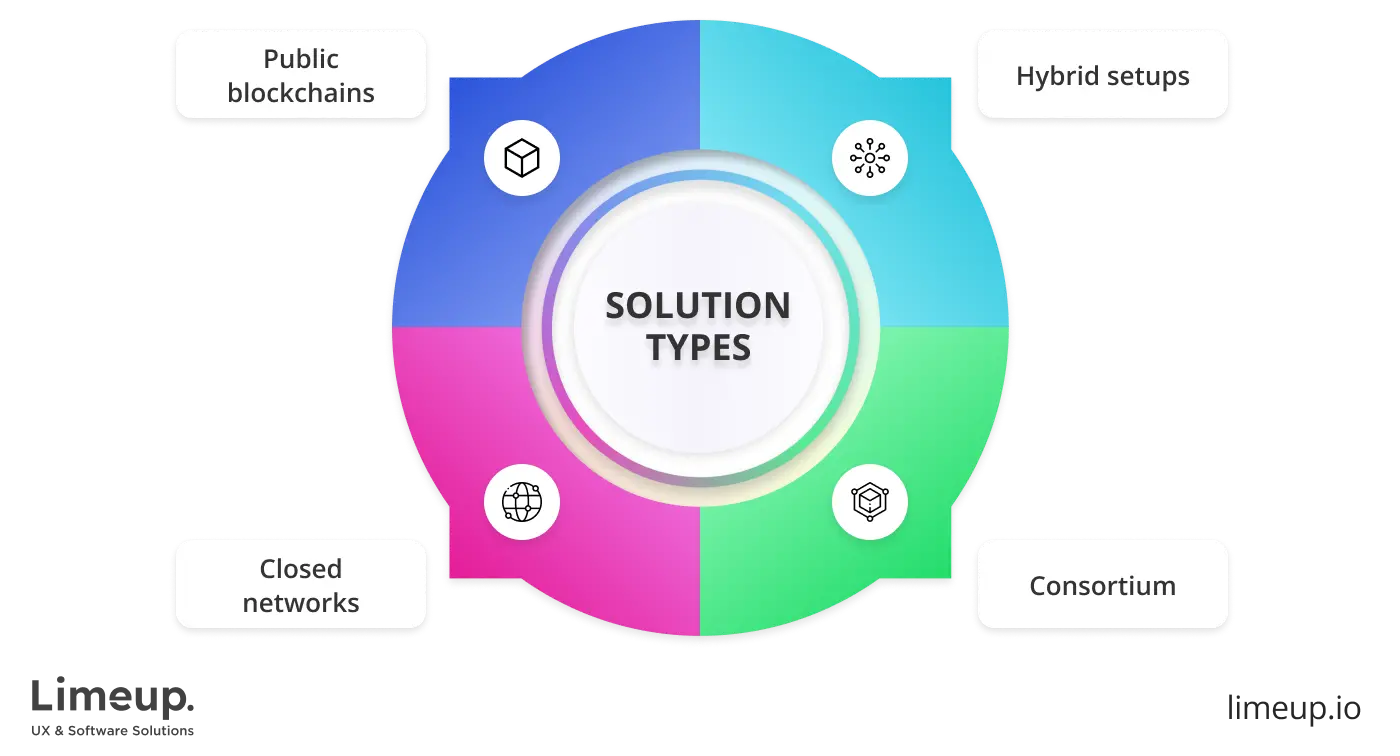
- Public blockchains are the wild west of decentralization. Bitcoin and Ethereum platforms invite anyone to join, validate, trade. Clear visibility is the order of the day here—every transaction is open to everyone’s view. The setup happens to suit individuals who prefer that trust develops through genuine work instead of secret distribution.
- Closed networks create an exclusive guest list that keeps sensitive information secure. It is accessible solely by approved members, frequently from the same organization. Access is strictly restricted, and keyholders are in charge of opening this safe haven. These private frameworks are especially helpful for businesses that prioritize asset management, logistics optimization and safe data.
- The model known as the consortium brings together components from both competition and collaboration mechanisms. The multiple organizations behind their creation have managed to establish both decentralized and structured frameworks. Such applications occur in medical partnerships and international supply chains as well as banking cartels since they enforce trust collaboration between competitors who share strategic info.
- Some doors stay open, others stay locked—hybrid setups give companies the keys to choose, depending on the stakes at hand.
Irrespective of type, every blockchain model makes the same golden thread into gold: a way to gain crystal-clear tracking, locked-tight architecture, lean functionality without dependence on a single point of failure. It’s less about chasing the trend and more about identifying what genuinely suits your project’s requirements.
What are the steps for developing blockchain software?
Constructing a blockchain application involves calculated planning, reliable resources, ability to address unexpected turns and complex paths. Players in the marketplace forecast the blockchain-as-a-service (BaaS) market to grow ($11,519 million by 2026) as more companies adopt the technology in an attempt to amplify functionality and uphold safe activities.
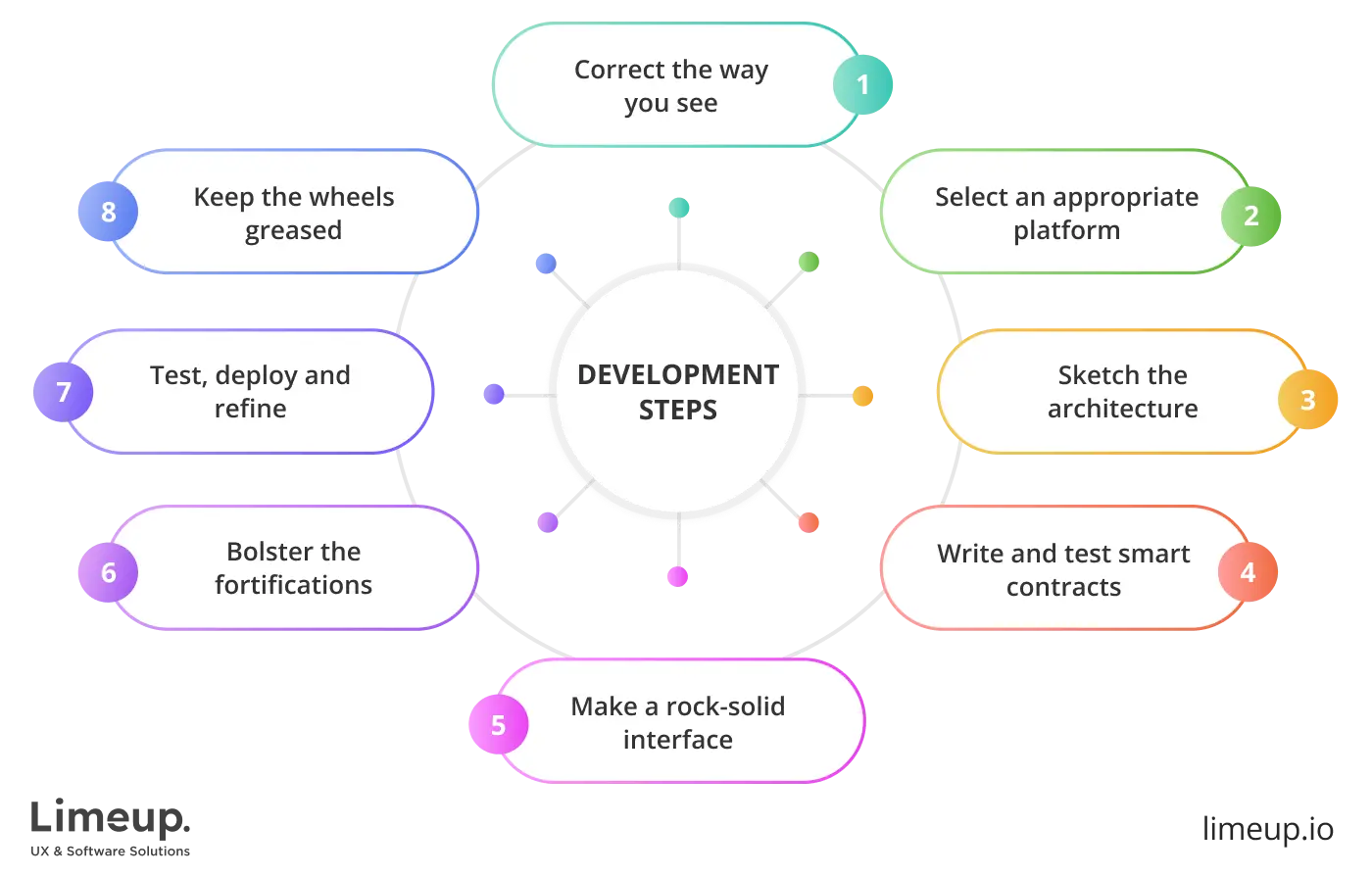
Step 1: Correct the way you see
It is better to use blueprints at the start of building rather than midway through. Determine exactly what you want the software to achieve before you start creating code or selecting tools. Everything that follows is shaped by specific goals, such as peer-to-peer funding or auditability. Budget slippage and false beginnings are to be expected in the absence of clear certainty. The saying goes, “A stitch in time saves nine.”
Budget slippage and false beginnings are to be expected in the absence of clear certainty. A vague idea leads to tangled features and bloated scope. Know what success should look like, otherwise, you’ll end up building someone else’s product. At Limeup, we always make sure the desired outcome is crystal clear before we start, so we’re building the right product, not just any product.
Step 2: Select an appropriate platform
It takes a steady touch and a clear eye to find optimal companion. While Hyperledger Fabric delivers enterprise-grade, permissioned networks with stability, Ethereum and Solana lead the way for decentralized applications. A nice sailing experience or a lifetime of upstream paddling might rely on how well your objectives align with the platform’s powers of attorney.
When determining how to develop a blockchain software, concentrate on what will work best for your project. Ignore the hype. Selecting what genuinely meets the requirements of the project is essential to its success. Reliability is not a function of popularity. Examine more in-depth real-world use cases to see which frameworks have withstood pressure in your industry.
Step 3: Sketch the architecture
Good architecture is the skeleton of resilient blockchain software. Stage 3 outlines how the pieces interact: permissions, participants, validation rules and fallback plans. Consensus mechanisms, governance models and node roles are all finalized here. Get those wrong and instead of building forward, you’ll spend your time unwinding problems you baked in early.
Each structural choice at this phase affects how fast, safe, scalable the system will be in practice. This is where theory meets terrain and shaky groundwork will rattle the entire build.
Step 4: Write and test smart contracts
Developers writing smart contracts operate in a high-stakes environment where every detail matters. Solidity and Rust become their battlegrounds as they test, tweak and tighten each function. The margin for error is zero. Building blockchain software isn’t a place for trial and error—there’s no room for “oops” moments.
To build blockchain software, leave no place for trial and error, there’s no room for “oops” moments. Flaws ignored during testing will come roaring back later. Only relentless evaluation keeps users and assets safe once everything goes live.
Step 5: Make a rock-solid interface
Even the most brilliant back-end needs a front porch that welcomes people in. Soon after, your first impression is your handshake, so a flashy user web page isn’t just for show. It all comes down to striking the ideal balance between form and function. Consider it more about making it solid and smooth than it is about making it beautiful.
The objective? UI that is effortless, where no one is confused about where to go next and every click seems natural. With each click, a well-designed layout promotes engagement, fosters trust and looks good. When users feel confident, they keep coming back.
Step 6: Bolster the fortifications
No software worth its salt leaves the gates open to unguarded access. Blockchain apps weave multi-layered protection into their very DNA: encryption, multi-factor authentication, regular penetration testing. In cut-throat world, where cybersecurity threats are as sharp as a tack, skipping this step is like leaving your valuables in an unlocked car on Main Street. Don’t do that.
Effective defense means staying on top of updates and keeping security keys closely guarded. It’s about being proactive, not reactive, in the ever-evolving world of digital threats. And here’s the kicker: when you build a blockchain app with security as a priority, you’re protecting your reputation. Trust is everything, so don’t skimp on the safety net.
Step 7: Test, deploy and refine
Prior to rollout, the entire build faces a series of rigorous tests(unit, integration, load) to confirm unified coordination between parts. Usually, the product is stress-tested outside of the sandbox on a testnet before being deployed.
Before full implementation, blockchain software developers actively try to find problems, fix anomalies and knock it into shape. The solution is deployed to the mainnet shortly after all problems have been resolved, battle-hardened and prepared for large-scale operation. Thorough testing reduces the possibility of unforeseen problems following release.
Step 8: Keep the wheels greased
Deployment is merely the start. Ongoing updates, user support and vigilance keep the blockchain system performing optimally. Individuals who snooze on upkeep may watch their software become out of date earlier than expected.
What are the key features of custom blockchain software development?
Personalized cryptographic software design is about making solutions that learn, in accordance with the latest technology updates and user demands. Every feature needs to be built with precision and flexibility, ready to evolve with the environment. So, how can you create an exceptional distributed application?
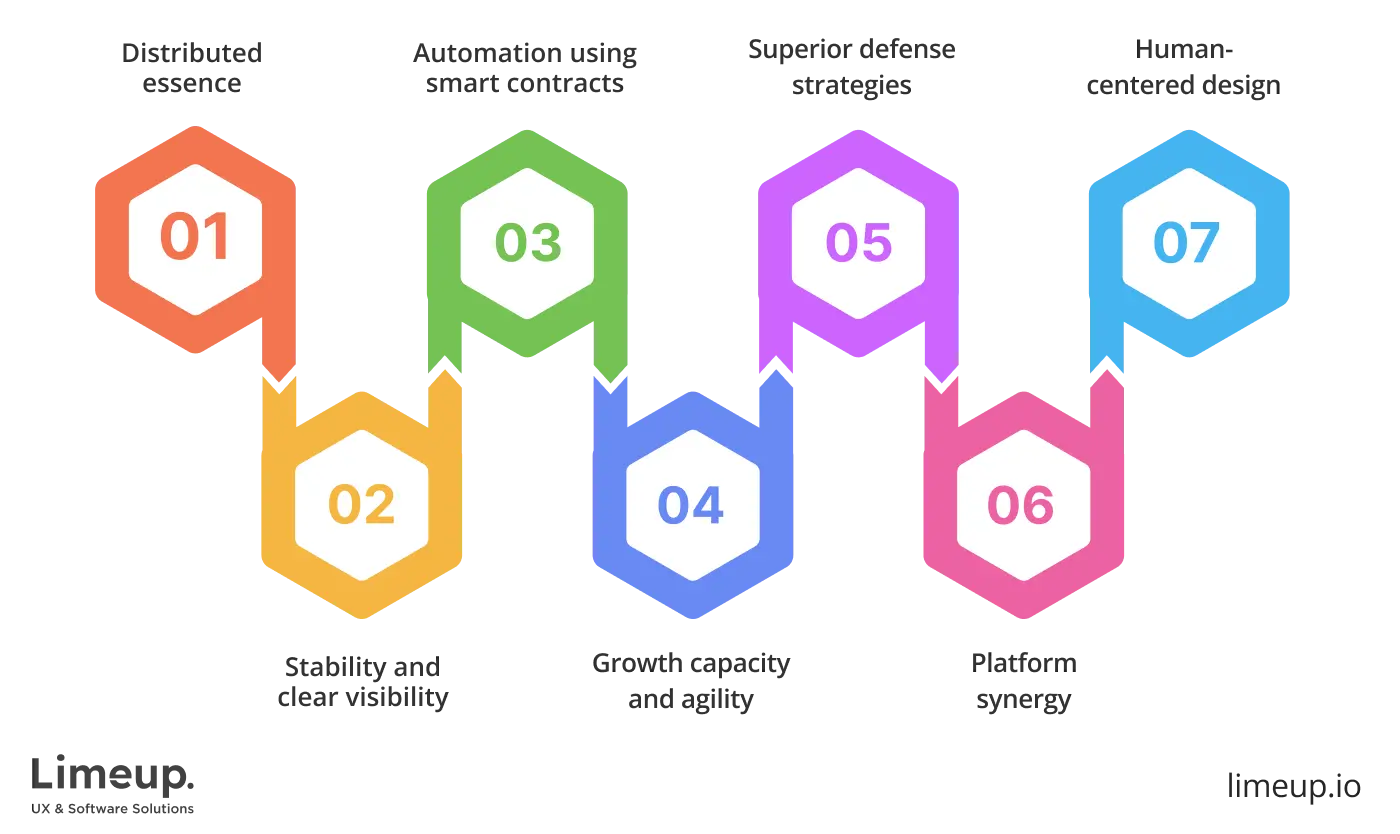
Distributed essence
Decentralization provides resistance to attack and breakdown since control isn’t put in any single point. For custom blockchain web development, decentralization forms the foundation, leaving no room for a single weak spot to bring down the entire product. The idea is still simple: more control to participants, less to central authorities. It is this that maintains the network stable, even if parts of it fail.
Stability and clear visibility
To create a blockchain solution that guarantees complete immutability, information remains permanently fixed in its designated place. This level of unalterable storage stands indispensable for finance and medical sectors because they rely heavily on trustworthiness and dependable systems.
Users with access are able to track every transaction easily , thanks to records that stay locked and untouchable. The open ledger keeps everything transparent, anyone involved has ability to follow the trail without worrying about hidden changes. With smart contracts running things automatically, there’s no need for go-betweens, and the risk of slip-ups drops to nearly zero.
Automation using smart contracts
The biggest modification to this digital architecture was the addition of smart contracts. Self-governing agreements may be carried out automatically and without the involvement of middlemen since they are directly inscribed into the logic.
Transactions are strong, self-driven and unyielding, much like a digital handshake. By using these cutting-edge services, users may automate payments, do identification checks, monitor assets, which leads to smooth operations and strengthened task flows.
Growth capacity and agility
The blockchain infrastructure needs to maintain outstanding performance levels when the user base of your app transitions from initial small numbers to large global numbers. The designed architectures adjust with the evolution of your project. Sharding alongside off-chain transactions offers developers ways to make a blockchain solution that may work effectively as their project’s requirements expand.
Superior defense strategies
Platforms in this space follow trusted standards while layering in clever safeguards to block unauthorized changes. Since every block links to the one before it, tampering attempts are immediately exposed. Security is embedded deep within the code itself, reinforcing the system at every level and keeping the framework secure from all sides.
The combination of Proof of Work and Proof of Stake consensus mechanisms together with cryptographic hashing and multi-signature protocols forms an absolute protection against unauthorized system entry.
Platform synergy
In a multi-blockchain environment, interoperability is essential, not optional. Blockchain software development solution syncs naturally with existing infrastructure and supports frictionless data movement across networks. Without strong interoperability, your design might look good on paper but stumble in practice.
Human-centered design
Blockchain doesn’t need to feel like a mystery to the user. A custom solution worth its salt treats user experience (UX) as a cornerstone, shaping interactions that feel second nature and lightning fast. Through a purified interface and optimized transaction paths, users remain in control and informed.
The aim is to deliver all the benefits of blockchain technology without overwhelming users with technical complexities. If your goal is a clean interface layered over powerful architecture, hire a blockchain developer to make it happen.
How much do blockchain software development services cost?
Fees range widely from simple to complex projects and require expert fintech app development firms’ skills and platform selection as well as elaborate features to determine pricing. Only by paying attention to specific elements, such as blind dart throwing, will you be successful in number guessing.
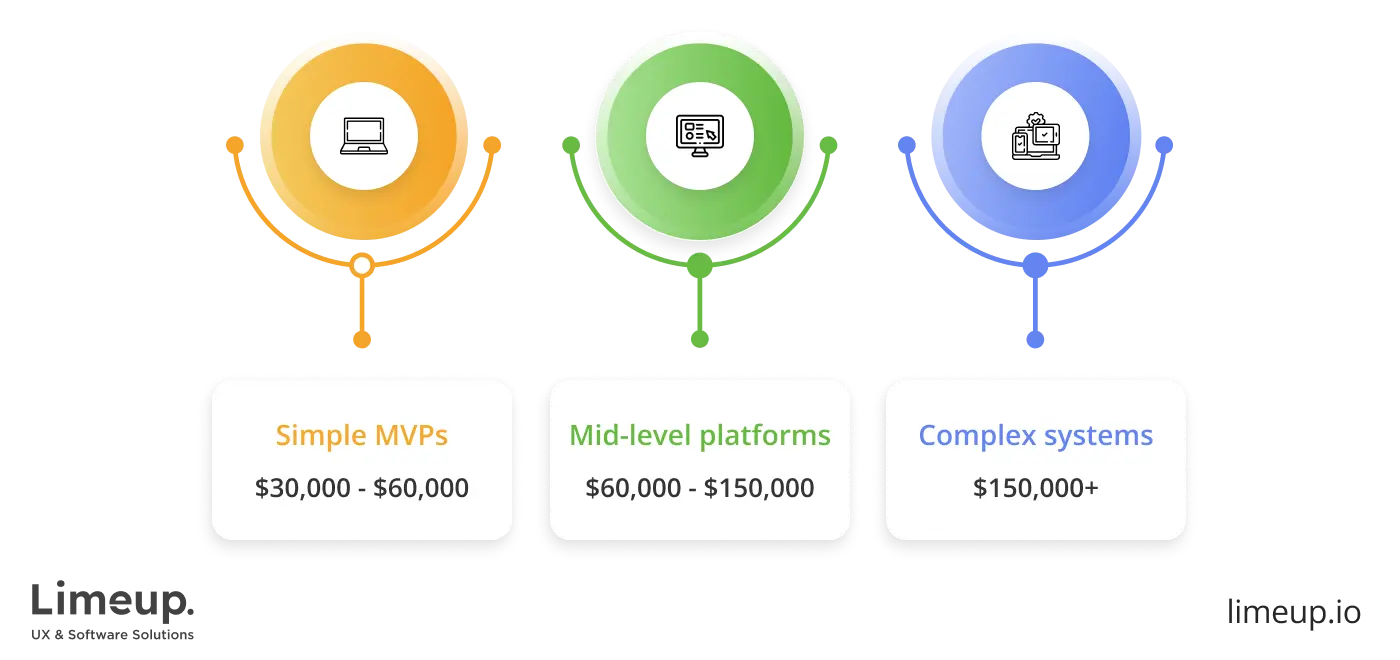
Depending on the complexity of the project, production costs for proof-of-concept applications or simple MVPs might range from $30,000 to $60,000. Our ten years of expertise demonstrate that higher project goals could result in an instant price increase. Construction expenses of high-end blockchain systems with smart contracts, token frameworks and cross-chain functionality surpass $150,000. And that’s just the start.
The necessary infrastructure components and complex integration needs will tend to increase project expenses significantly. The price should not discourage you from proceeding with the project. Analysis by market insiders expects the blockchain market soaring to $746.41 billion during the period between 2032 and 2033. Technical experts strongly believe this technology will boost dramatically within the next few decades because its trajectory is accelerating steadily.
Entering the field of custom blockchain software development currently will put you ahead of the competition while you benefit from its increasing global adoption throughout the years. Your investment today might function as the gateway to obtaining business framework that will secure your endeavor against future uncertainty. A number of elements shape the final expenses.
Factors influencing prices
To understand better, take a look at price-point triggers: the tiniest button and the most complex back-end logic chip away at the budget. What begins as a sleek idea may quickly snowball once layers of features pile up, bugs burrow in and testing stretches thin.
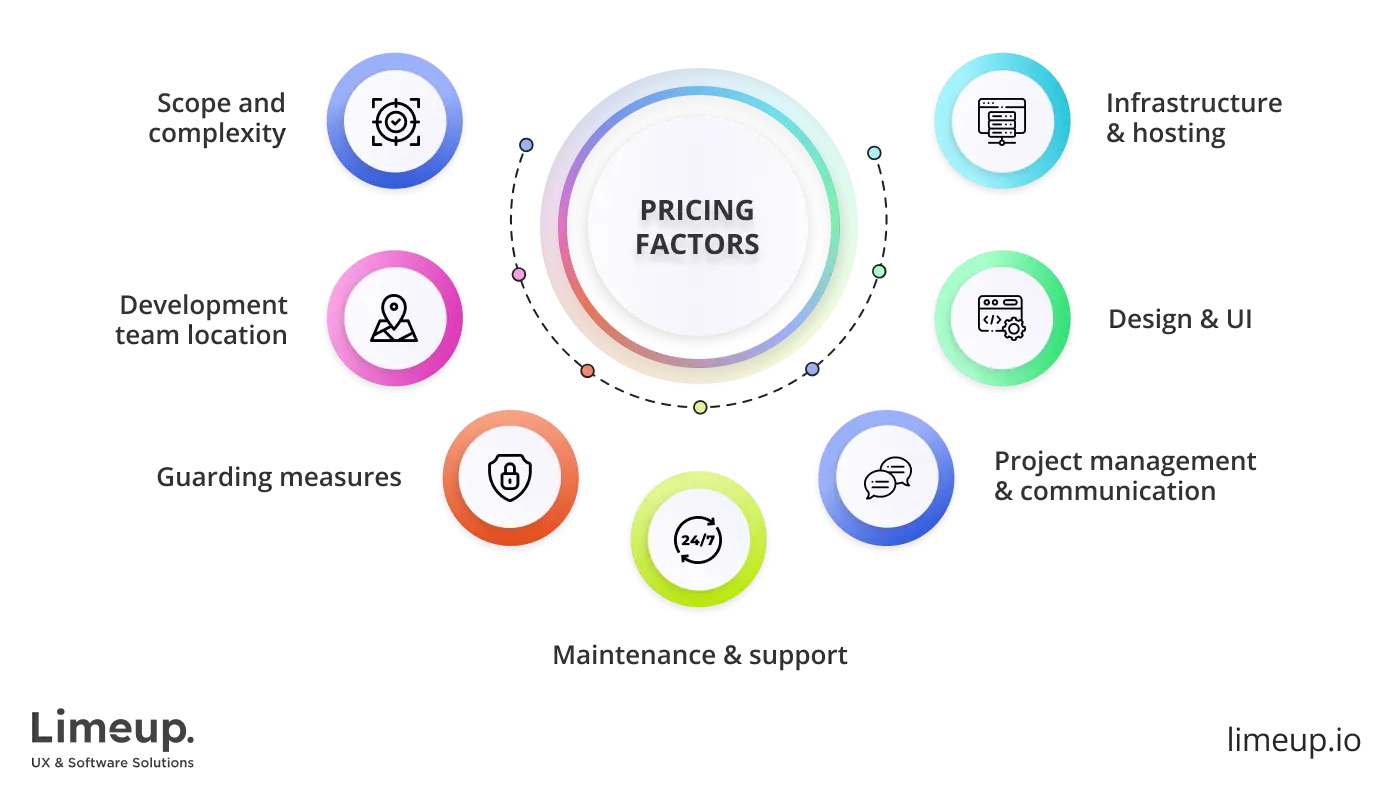
Scope and complexity
Basic decentralized app won’t suck as much budget as a sprawling financial system with all the moving parts. Each additional feature adds new layers of design, testing, shielding.
Development team location
Skimping on quality will catch up with you eventually—cutting corners on talent usually costs more in the long run. Blockchain software developer location often dictates the going rate (more on that later).
Guarding measures
Bypassing fortification features is like patching a leaky roof with duct tape. Thorough audits, encryption and test-running smart contracts sum up expenses, but these are expenditures well worth it.
Maintenance and support
Blockchain applications are dynamic beings—they evolve. Investing 15–20% of the initial expense every year on maintenance keeps bugs in check and performance sharp.
Project management and communication
An unshakable coding roadmap, regular updates and tight feedback loops don’t materialize out of thin air. Project managers, Scrum masters and coordinators bring order to the creative chaos, and yes, their time is billed too.
Design and UI
A clunky, ugly dApp drives users away faster than you can say “404 error.” Investing in clean UX/UI, mobile optimization and smooth user flows bumps up the budget, but saves your reputation. Bad layout is a cost you pay twice.
Infrastructure and hosting
Think nodes, cloud storage, gas fees, uptime guarantees. Hosting decentralized apps or running your own node racks up costs that aren’t always visible up front but will bite later if ignored.
Rates for blockchain software developers
Where your programmers place their hats is a large driver of your end expenses. Talent communities with diverse locations have very disparate price tags, not always reflecting a reduction in capability. Here is a quick overview of how hourly rates divide across the world:
| Region | Average hourly rate | Notes |
| North America | $120–$200 | High expertise, faster project scaling |
| Western Europe | $100–$180 | Strong technical base, premium pricing |
| Eastern Europe | $50–$100 | Great value without cutting corners |
| South America | $40–$90 | Affordable, growing blockchain scene |
| South and Southeast Asia | $30–$80 | Budget-friendly, varied experience |
Jumping into building a blockchain without a durable fiscal plan is a recipe for disaster. Every change, feature inclusion, or improvement drives the cost higher. Laying down clear intentions from the start helps avoid spiraling costs and wishful thinking. Serious blockchain investment triggers a leap few can match, turning smart budgets into bridges that stand the test of time while others watch from the sidelines.
How to choose the right blockchain software development company?
Hiring an engineering agency is more like assembling well-versed individuals for a high-stakes job than just making a selection from a list. You need specialists, not flash-in-the-pan showmen. There are so many blockchain development companies out there hiding in the underbrush, finding the builders between the buzzmakers is the real challenge.
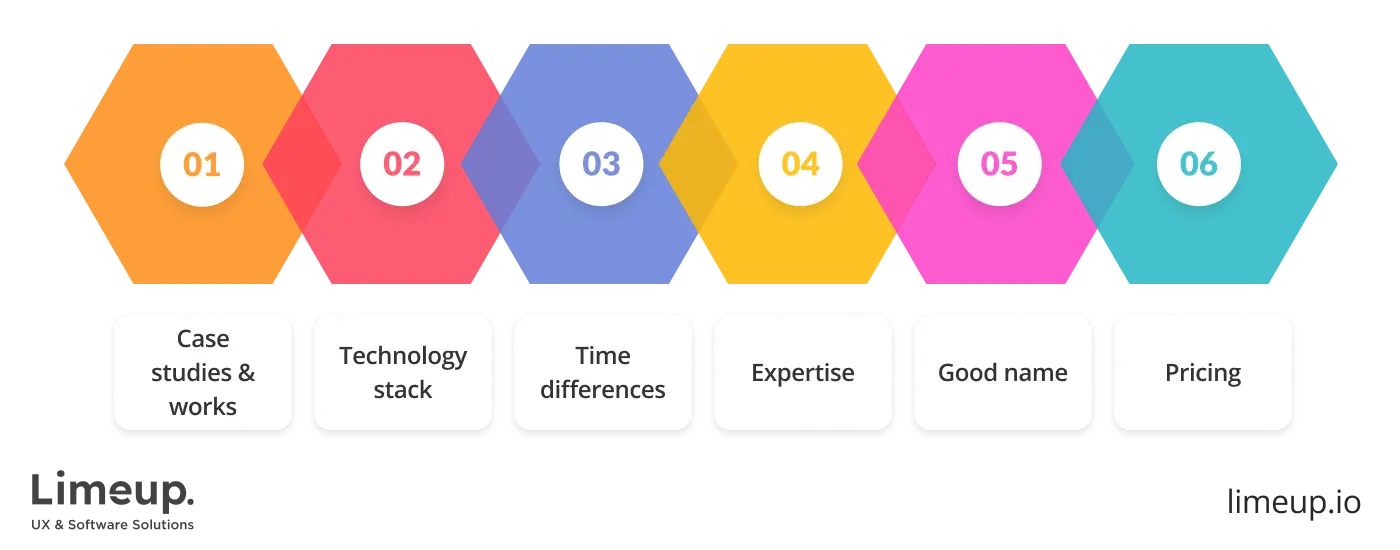
Start by taking a look past the gilded case studies. Portfolios may be blinding, but hell is in the details. Ask how each project was approached, what issues they faced and how they solved them. Genuine professionals don’t hide behind sophisticated graphics. They make the trade-offs clear, help chart the best-fit course and offer no-nonsense guidance.
Technology stacks of blockchain in software development come and go, but attitude remains. The best company won’t try to shoehorn your idea into their comfort zone. They’ll tune into your objectives, handpick tools that fit like a glove and lay things out without slipping into tech-speak. If they are able to understand complex systems and communicate simply, that’s worth more than gold.
Next, see how they actually work. Do things run clean, or are they winging it behind the scenes? Do they sprint, test thoroughly and keep you informed without spamming your inbox with chaos? Good project management is the unsung force behind successful delivery. Tech builders who stay on top of documentation, maintain strong communication and adhere to schedules are invaluable in the crypto space.
Time differences combined with cultural diversity between groups may create unrealistic difficulties in collaboration although physical presence remains flexible. The outcome of your teamwork will suffer if you continue participating in meetings without adequate response from your counterparts. Pick a group where smooth coordination and communication are second nature.
Expertise counts more than promises. Demand concrete answers from all potential fintech software development vendors. Does their financial staff demonstrate capabilities in implementing token ecosystems as well as optimizing gas levels and integrating cross-chain solutions? If they hesitate on specifics, it’s a sign that they might be in over their heads. You require veterans, not tourists.
A good name in blockchain software development outsourcing travels fast. Review their portfolio, check GitHub for recent work and see if their blog shows depth or just buzzwords. True players show their hand by consistent effort, not slogans. Select a workforce that delivers without vanishing half-way through the game.
If the pricing sounds like a magic trick, take a closer look. Every dollar should tie back to something real: interface design, contract logic, audits, or post-launch care. If the estimate feels polished but vague, dig deeper. Smoke and charm won’t fix sloppy code.
The real players in blockchain development don’t just take orders. They lean in, challenge weak strategies and offer sharper ones. They move fast, fix faster and treat your project like something that should make waves, not collect dust.
Why choose Limeup for your blockchain solution?
Real organizational change relies on blockchain technology as it implements stronger supply chain management and secure transaction environments while optimizing business operations throughout various industries. The level of success achieved through the technology of software development for blockchain depends directly on its construction quality. A qualified implementation exceeds code basics because it demands focused leadership and experienced personnel.
The industry changes rapidly while timing represents a key operational factor. The combination of ambition and expertise eliminates all boundaries in breakthrough innovations. We’re here to join forces with organizations eager to push boundaries and looking to transform their business vision into sustainable construction projects swiftly and powerfully, yet permanently.
Our savants’ mastery of the field drives them to build resilient solutions with an eye for the future. Limeup is ready to build something meaningful with those who have completed their dreaming phase. Launch your project development process by contacting us to create disruptive products.

